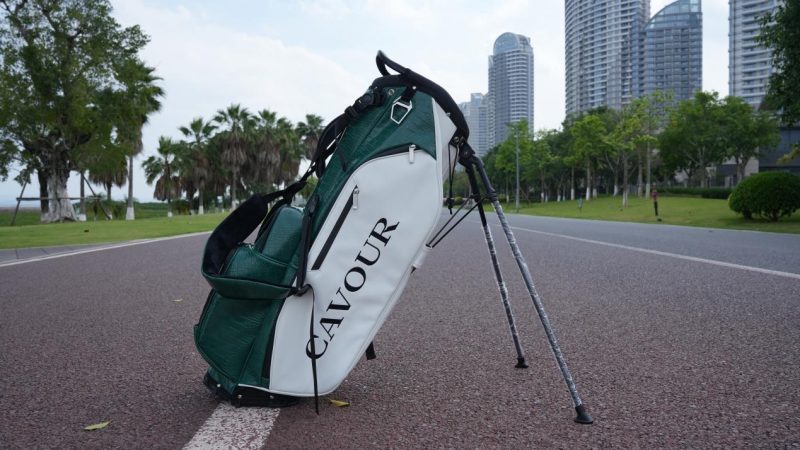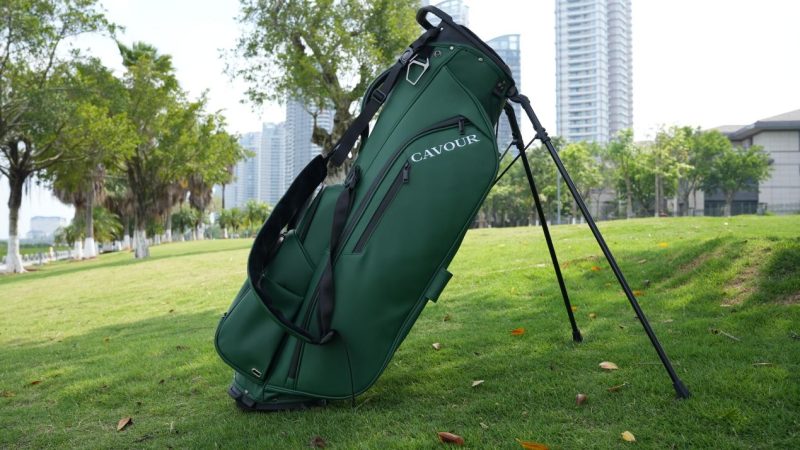Forget the clubs for a moment. Your golf bag is the unsung hero (or villain) of every single round. It’s your mobile command center, your equipment guardian, your constant companion across 18 holes. Choose poorly, and you’re saddled with frustration, backache, and disorganized chaos. Choose wisely, and you unlock comfort, convenience, and maybe even a few strokes saved through better focus and preparedness. This comprehensive guide dives deep into the critical factors for selecting the perfect golf bag for your game.
Why Your Golf Bag Choice Matters More Than You Think
It’s not just a sack for your clubs. Your bag fundamentally impacts:
◆ Physical Comfort & Fatigue: A poorly designed or heavy bag, especially if you walk, leads to back, shoulder, and arm strain. Comfort directly affects your energy levels and swing late in the round.
◆ Course Management & Pace of Play: Easy access to clubs, balls, tees, and rangefinders keeps you organized and moving efficiently. Fumbling costs time and rhythm.
◆ Equipment Protection & Longevity: Quality bags shield your expensive clubs from chatter damage, the elements (sun, rain, moisture), and accidental drops.
◆ Convenience & Preparedness: Adequate storage for essentials (rain gear, extra layers, snacks, valuables) means you’re ready for anything the course throws at you.
◆ Personal Style & Enjoyment: Let’s be honest, a bag you like the look of adds a touch of pride and enjoyment to your round.
Navigating the Golf Bag Landscape: Core Types
The first major decision hinges on how you primarily play:
■ 1. Cart Bags (The Feature-Rich Workhorse):
* Design: Built specifically to ride securely on motorized or push/pull carts. Typically larger and heavier.
* Key Features:
* Top: Often a 15-way top (or 14+ putter well) for maximum club organization and protection.
* Storage: CHAMPIONS storage! Multiple large, specialized pockets: insulated cooler pockets, full-length apparel pockets, dedicated rangefinder/valuables pockets, numerous accessory pockets. Think “golfing suitcase.”
* Stability: Wider base for stability on the cart. May have non-slip or strap-friendly bases.
* Putting Well: Almost always includes an easily accessible putter well.
* Pros: Ultimate organization, maximum storage, excellent club protection, easy access on a cart.
* Cons: Heaviest option, cumbersome to carry any distance, can be top-heavy if poorly designed.
* Best For: Golfers who primarily ride in a cart, value maximum organization and storage, and don’t mind the weight.
■ 2. Stand Bags (The Versatile All-Rounder):
* Design: The most popular choice. Features built-in retractable legs activated when you set the bag down, keeping it upright and clubs accessible anywhere on the course.
* Key Features:
* Legs: Dual legs with durable feet. Look for stability and smooth retraction mechanisms.
* Top: Usually 4-way, 5-way, 6-way, or 14-way tops. Balance organization with weight.
* Weight: Prioritizes lighter materials (though varies greatly). Carrying comfort is paramount.
* Storage: Good pocket configuration – typically several apparel/accessory pockets, a valuables pocket, and often a cooler pocket (smaller than cart bags). Pockets designed for easy access while walking.
* Straps: Dual, well-padded, ergonomic straps (often convertible to single strap) are crucial. Look for comfort tech.
* Pros: Excellent versatility (suitable for carrying, push carts, and riding carts), good storage, keeps clubs upright and accessible, generally lighter than cart bags.
* Cons: Less storage than cart bags, smaller tops can sometimes cause club tangle (depends on design), legs add slight weight/complexity.
* Best For: Golfers who walk frequently (with or without a push cart), occasional riders, those wanting the best balance of features and weight. The most versatile choice.
■ 3. Carry Bags (Sunday Bags / Ultralight):
* Design: Minimalist. Focuses purely on lightweight carrying. Usually lacks legs.
* Key Features:
* Weight: Extremely light (often under 3-4 lbs).
* Top: Simple 3-way or 4-way top, or even a single divider tube. Minimal club separation.
* Storage: Very limited – maybe 1-2 small pockets for essentials (balls, tees, wallet).
* Straps: Single strap (sometimes convertible) for simplicity.
* Pros: Absolute lightest option, simplest design, easy to carry for short walks or quick practice sessions.
* Cons: Virtually no club protection (lots of chatter), minimal storage, clubs fall over constantly, uncomfortable for a full 18 unless supremely fit.
* Best For: Short courses, par-3 courses, practice range sessions, travel (as a backup), or the ultra-minimalist golfer carrying only a half-set.
■ 4. Staff Bags (The Tour Pro Look & Heavy-Duty Hauler):
* Design: Large, heavy, traditionally used by caddies carrying for tour pros. Often branded heavily for players.
* Key Features:
* Size & Weight: Largest and heaviest type (10+ lbs empty is common). Premium materials (often leather or heavy synthetic).
* Storage: Massive storage capacity, similar to high-end cart bags but often more robustly built.
* Durability: Built to withstand rigorous travel and constant use.
* Image: Projects a classic, professional aesthetic.
* Pros: Ultimate durability, immense storage, maximum club protection, prestigious look.
* Cons: Extremely heavy, expensive, impractical for carrying (designed for caddies/carts), bulky.
* Best For: Golf professionals, elite amateurs with caddies, golfers who exclusively ride and want the ultimate durable bag with max storage and a tour look. Not for walkers.
■ 5. Travel Bags (The Essential Protector):
* Design: Not for the course itself! These are sturdy cases (hard or soft shell) designed specifically to protect your golf bag and clubs during airline travel.
* Key Features: Padding, structure (hard cases), wheels, durable exterior materials, often TSA-approved locks.
* Critical: NEVER check your clubs in just your regular golf bag. A dedicated travel bag is mandatory for safe air travel.
Choosing Your Perfect Match: Key Selection Criteria
Once you’ve identified the primary type (likely Stand or Cart for most), drill down with these factors:
- 1. Top Design & Club Management:
* Full-Length Dividers vs. Individual:Do dividers run the full length of the bag (best protection, prevents grip tangling) or just partway? Full-length is superior.
* Number of Dividers: More dividers (14-way) = better organization & protection but can be bulkier/heavier. Fewer dividers (4-way, 5-way) = lighter weight, potential for club tangle. Consider: How many clubs do you carry? Do you have oversized grips? How much does club chatter annoy you?
* Putter Well: Is there a dedicated, easily accessible slot for your putter? Highly recommended. - 2. Weight: The Burden or the Blessing:
* Empty Weight:Crucial for walkers! Stand bags range from under 4 lbs (ultralight) to over 6 lbs. Cart/Staff bags are heavier (5-10+ lbs).
* Loaded Weight: Remember to factor in clubs (15-20 lbs), balls, water, gear! A 5-lb bag becomes 25+ lbs quickly. Lighter bags significantly reduce fatigue. - 3. Storage & Pockets: Your Mobile Locker:
* Apparel Pocket:Size matters! Can it hold a jacket, sweater, or rain pants? Is it full-length?
* Cooler Pocket: Insulated? How big? Can it hold multiple drinks/snacks?
* Valuables Pocket: Padded? Zippered? Water-resistant? Secure for phone, wallet, keys.
* Rangefinder Pocket: Dedicated, often fleece-lined? Easy access?
* Accessory Pockets: Enough for balls, tees, gloves, tools, sunscreen? Well-organized?
* Access: Are pockets easy to open/close while wearing a glove? Placement matters when the bag is on your back or a cart. - 4. Comfort & Carrying System (For Stand/Carry Bags):
* Straps:Dual straps are essential for walking. Look for:
* Padding: Thick, breathable foam.
* Ergonomics: Contoured to fit shoulders/back. Padded lumbar support?
* Adjustability: Easy to customize fit.
* Dual/Single Convertible? Some offer flexibility.
* Brand Tech: Look for systems like Titleist’s 4-way, Ping’s Hoofer, Sun Mountain’s 4.5 LS – designed for comfort.
* Hip Pad: Does it have a padded hip pad for extra stability and weight distribution?
* Balance: How does the bag feel when loaded on your shoulders? Does it sag or pull awkwardly? - 5. Durability & Materials: Built to Last:
* Fabric:High-denier polyester (e.g., 600D, 900D, 1200D+) or nylon is standard. Higher denier = tougher but heavier. Leather (Staff) is premium but high-maintenance.
* Zippers: Quality YKK zippers are a good sign. Water-resistant zippers are a bonus.
* Stitching: Reinforced stitching at stress points (straps, legs, pocket seams).
* Legs & Feet: Sturdy construction, metal components often better than plastic. Non-slip feet.
* Base: Reinforced, waterproof base is ideal. - 6. Extras & Personal Touches:
* Rain Hood:Is one included? Fits well? Easy to deploy? Essential gear!
* Umbrella Holder/Sleeve: Secure and easy access.
* Towel Ring/Loop: Convenient for your go-to towel.
* Glove Holder: Keeps it handy and aired out.
* Pen/Pencil Holder: Small but useful.
* Colors & Branding: Find one that matches your style!
Putting It All Together: Your Selection Checklist
Primary Use: Walk? Push Cart? Ride? Mostly walking = Stand Bag. Mostly riding = Cart Bag.
Weight Priority: Ultra-lightweight? Feature-rich? Find the balance. Walkers: Prioritize Lightness!
Storage Needs: Minimalist? Pack mule? Match pockets to what you actually carry. Be realistic.
Organization: Need meticulous club separation (14-way) or prefer simpler (5-way)? Hate club tangle?
Comfort (Walkers): TRY IT ON LOADED! Test the straps, balance, and hip pad. This is non-negotiable.
Durability: Will it last multiple seasons? Check materials and construction.
Budget: Set a realistic range. Premium features (ultralight materials, top strap systems) cost more.
Try Before You Buy (If Possible):
Load it with demo clubs (or similar weight).
Practice taking clubs in and out.
Test the stand mechanism.
Open and close pockets.
Wear it! Walk around the store.
Final Thoughts: Invest in Your On-Course Experience
Your golf bag is a crucial piece of equipment that impacts your enjoyment and performance every single time you play. Don’t treat it as an afterthought. By carefully considering how you play, what you carry, and the features that matter most to you (especially comfort if you walk!), you can make an informed decision. Remember, the perfect bag feels like an extension of yourself – organized, comfortable, reliable, and ready to tackle the challenges and joys of the course. Take your time, do your research, and invest in a bag that will be a trusted partner for countless rounds to come.
ENJOY YOUR GAME!


